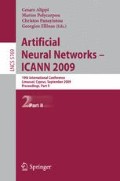Abstract
Model complexity is key concern to any artificial learning system due its critical impact on generalization. However, EC research has only focused phenotype structural complexity for static problems. For sequential decision tasks, phenotypes that are very similar in structure, can produce radically different behaviors, and the trade-off between fitness and complexity in this context is not clear. In this paper, behavioral complexity is measured explicitly using compression, and used as a separate objective to be optimized (not as an additional regularization term in a scalar fitness), in order to study this trade-off directly.
Access this chapter
Tax calculation will be finalised at checkout
Purchases are for personal use only
Preview
Unable to display preview. Download preview PDF.
References
Baronchelli, A., Caglioti, E., Loreto, V.: Artificial sequences and complexity measures. Journal of Statistical Mechanics (2005)
De Jong, E.D., Pollack, J.B.: Multi-objective methods for tree size control. Genetic Programming and Evolvable Machines 4(3), 211–233 (2003)
De Jong, E.D., Watson, R.A., Pollack, J.B.: Reducing bloat and promoting diversity using multi-objective methods. In: Spector, L., Goodman, E.D., Wu, A., Langdon, W.B., Voigt, H.-M., Gen, M., Sen, S., Dorigo, M., Pezeshk, S., Garzon, M.H., Burke, E. (eds.) Proceedings of the Genetic and Evolutionary Computation Conference, pp. 11–18. Morgan Kaufmann, San Francisco (2001)
Deb, K., Pratap, A., Agarwal, S., Meyarivan, T.: A fast and elitist multiobjective genetic algorithm: NSGA-II. IEEE Transaction on Evolutionary Computation 6, 182–197 (2002)
Gomez, F.: Sustaining diversity using behavioral information distance. In: Proceedings of the Genetic and Evolutionary Computation Conference (to appear, 2009)
Iba, H., Garis, H.D., Sato, T.: Genetic programming using a minimum description length principle. In: Advances in Genetic Programming, pp. 265–284. MIT Press, Cambridge (1994)
Li, M., Vitányi, P.M.B.: An introduction to Kolmogorov complexity and its applications. In: van Leeuwen, J. (ed.) Handbook of Theoretical Computer Science, pp. 188–254. Elsevier Science Publishers B.V., Amsterdam (1990)
Rissanen, J.: Modeling by shortest data description. Automatica, 465–471 (1978)
Teller, A.: Advances in Genetic Programming, ch. 9. MIT Press, Cambridge (1994)
Toffolo, A., Benini, E.: Genetic diversity as an objective in multi-objective evolutionary algorithms. Evolutionary Computation 11(2), 151–167 (2003)
Togelius, J.: Optimization, Imitation and Innovation: Computational Intelligence and Games. PhD thesis, Department of Computing and Electronic Systems, University of Essex, Colchester, UK (2007)
Zhang, B.-T., Muhlenbein, H.: Evolving optimal neural networks using genetic algorithms with occam’s razor. Complex Systems 7, 199–220 (1993)
Zhang, B.-T., Muhlenbein, H.: Balancing accuracy and parsimony in genetic programming. Evolutionary Computation 3, 17–38 (1995)
Zhang, B.-T., Mühlenbein, H.: MDL-based fitness functions for learning parsimonious programs. In: Siegel, E.V., Koza, J.R. (eds.) Working Notes for the AAAI Symposium on Genetic Programming, November 10–12, pp. 122–126. MIT, Cambridge (1995) AAAI
Zhang, B.-T., Ohm, P., Mühlenbein, H.: Evolutionary induction of sparse neural trees. Evolutionary Computation 5(2), 213–236 (1997)
Ziv, J., Lempel, A.: Compression of individual sequences via variable-rate coding. IEEE Transactions on Information Theory (September 1978)
Author information
Authors and Affiliations
Editor information
Editors and Affiliations
Rights and permissions
Copyright information
© 2009 Springer-Verlag Berlin Heidelberg
About this paper
Cite this paper
Gomez, F.J., Togelius, J., Schmidhuber, J. (2009). Measuring and Optimizing Behavioral Complexity for Evolutionary Reinforcement Learning. In: Alippi, C., Polycarpou, M., Panayiotou, C., Ellinas, G. (eds) Artificial Neural Networks – ICANN 2009. ICANN 2009. Lecture Notes in Computer Science, vol 5769. Springer, Berlin, Heidelberg. https://doi.org/10.1007/978-3-642-04277-5_77
Download citation
DOI: https://doi.org/10.1007/978-3-642-04277-5_77
Publisher Name: Springer, Berlin, Heidelberg
Print ISBN: 978-3-642-04276-8
Online ISBN: 978-3-642-04277-5
eBook Packages: Computer ScienceComputer Science (R0)

